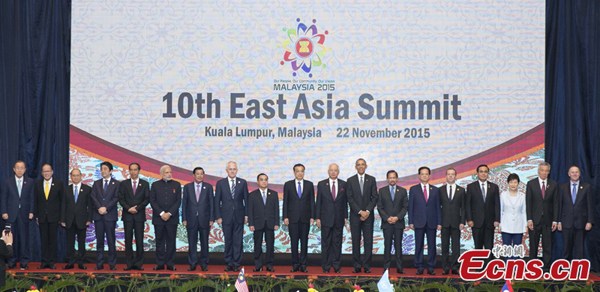
Premier Li Keqiang (center) and other participating leaders take part in a group photo during the East Asia Summit at the Kuala Lumpur Convention Centre in Kuala Lumpur on Sunday, Nov. 22, 2015. (Photo/China News Service)
Just a few days after President Xi Jinping returned from the APEC economic leaders' meeting in Manila, Premier Li Keqiang attended the 18th China-ASEAN (10+1) Summit, the 18th ASEAN Plus Three (10+3) Summit and the 10th East Asia Summit in Kuala Lumpur. [Special coverage]
Cooperation between China and the Association of Southeast Asian Nations has always been a vital topic at these annual meetings. And the two successive trips made by China's top leaders to Southeast Asia signify the increasing importance of ASEAN in regional politics as well as in China's diplomatic strategy.
The ASEAN-related meetings and the EAS are expected to further boost cooperation between China and ASEAN, which in turn will help the implementation of China's Silk Road Economic Belt and 21st Century Maritime Silk Road proposals, also known as the Belt and Road Initiative, to the benefit of the entire region. Regional cooperation can be deepened also by implementing the Phnom Penh Development Declaration, which was adopted in November 2012.
More importantly, China and ASEAN are expected to conclude the talks on upgrading the China-ASEAN Free Trade Area. Since China is already ASEAN's largest trade partner while ASEAN is China's third-largest, an upgraded FTA will increase their importance for each other on the trade map.
That would be in conformity with what President Xi said in his speech at the APEC meeting, in which he emphasized the importance of deepening regional cooperation through the Belt and Road Initiative. Xi also laid stress on promoting interconnectivity both among ASEAN members and between the trade bloc and other economies through the China-led Asian Infrastructure Investment Bank.
These moves are of special strategic significance to China because ASEAN occupies a key point on the Belt and Road Initiative. As neighbors, ASEAN member states have also forged many cooperation programs with China, including those on the cultural, scientific and environmental protection fronts.
But despite all these positive developments, there are challenges ahead. And they can be overcome only with the joint efforts of the two sides.
A major challenge is China's economic slowdown. China-ASEAN cooperation deepened in the first decade of this century because of China's fast-paced economic growth, which boosted the regional economy, and ASEAN's booming trade with China, which sustained the latter's growth. Now that the Chinese economy has entered the "new normal" of slower but sustainable and eco-friendly growth, many of its neighbors are also facing some economic problems.
Another challenge is China's maritime disputes with some of its Southeast Asian neighbors. These disputes in the South China Sea are bilateral rather that regional issues, but some Southeast Asian countries are trying to rally support from ASEAN to buttress their claims even though the trade bloc is supposed to strengthen regional cooperation, not resolve territorial disputes.
Besides, Japan and the United States want to drive a wedge between China and ASEAN by internationalizing these disputes. Japanese Prime Minister Shinzo Abe has raised the South China Sea disputes many times at bilateral and multilateral diplomatic forums. And the U.S. is using the pretext of freedom of navigation in the South China Sea to raise tensions in the region and seek the support of its allies like the Philippines, in order to implement its "pivot to Asia" strategy to check China's rise.
To foil such divisive attempts, China should adhere to its "dual-track" policy under which bilateral disputes should be resolved through bilateral talks while continuing to cooperate with ASEAN to maintain regional stability. Only by using the "dual-track" policy can China prevent its maritime disputes with some Southeast Asian countries from creating obstacles in China-ASEAN ties and derailing China-ASEAN trade talks.
The author, Bao Xiaqin, is an associate professor on international relations and public affairs at Fudan University.


















































